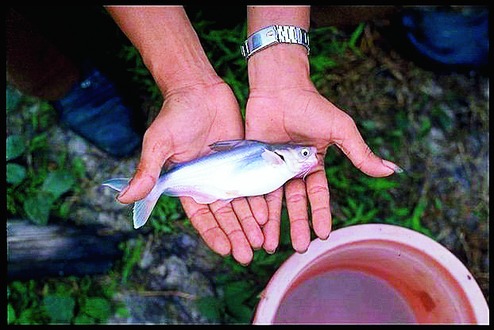
Patna: Bihar has achieved success in breeding Pangasius fish for the first time. The successful breeding took place at the Baheri fish farm in Darbhanga district. More than 40 per cent of the Pangasius spawns survived after breeding. The fisheries directorate is awaiting a formal report from the field after which it would be then sent to the Indian Council of Agriculture Research.
The development assumes significance as Pangasius farming has gained currency in several states, including Bihar, owing to its high demand and very good productivity. Two states - Jharkhand and Chhattisgarh - have so far unsuccessfully tried Pangasius breeding.
In most of the states where fish farmers opt for Pangasius farming, the fish seed is supplied from Bengal, who in turn, have links with the seed farmers of Bangladesh for getting their supply.
"Successful breeding of Pangasius fish is a major achievement for us as the indigenously bred seeds would not only get easily acclimatised if transferred to other parts of the state but it would also reduce the input cost which fish farmers in Bihar at present have to bear owing to the import of fish seeds from Bengal," a senior official at the state fisheries directorate said.
According to market sources, fish farmers in Bihar purchase Pangasius fishling for rates ranging from Rs 5 to Rs 7 per piece whereas the indigenously produced seed would be available to them for Rs 3 to Rs 4 per piece.
At present, fish farmers from Buxar, Rohtas, Bhojpur, Aurangabad, Nalanda, Siwan, Saran, Gopalganj, Muzaffarpur and Samastipur are opting for Pangasius farming. These farmers purchase around 15 to 16 lakh fish seeds every year from suppliers in Bengal.
"We intend to produce 5 lakh seeds in the current year and by improving our breeding facilities in different fish farms, we would try to meet the seed demand locally in the coming years," said the official.
Apart from being rich in protein and high-density cholesterol, Pangasius fish have just one bone and hence are widely used for making cutlets, momos and other dishes in which fish flesh is used. Hence, apart from being a good food item for common people, the Pangasius fish also remains high in demand as far as hotels and restaurants are concerned. The most important aspect of Pangasius fish is its fast growth which allows farmers to get high productivity.
"While we achieve around 3 tonnes of production in one hectare of water body in case of farming of Indian major carps like Rohu, Katla and Mrigal, in case of Pangasius, the productivity level of 20 tonnes per hectare can easily be achieved which can be scaled up to 40 tonnes," said the official and added that wide-scale farming of this fish, which an indigenous variety from Vietnam, would help Bihar achieve the target of producing 8 lakh metric tonnes of fish by 2022 as envisaged in the third agriculture roadmap.
Against its need of 6.42 lakh metric tonnes of fish annually, Bihar at present produces 5.10 lakh metric tonnes. The per capita annual consumption of fish in the state is 7.7 kg per person whereas the nati onal average is 10 kg per person. According to recommendations of the Indian Council of Medical Research, ideally an individual should consume 11.2 kg of fish every year.
Bihar has no dearth of water bodies and the state boasts of 93,000 hectares of ponds, 9,000 hectares of oxbow lakes, 9.41 lakh hectares of chaur (low) lands which remain submerged for six to seven months a year, 26,000 hectares of reservoir and 3,200km of rivers.











